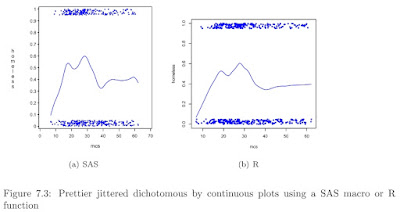SAS
%macro logiplot(x=x, y=y, data=, jitterwidth=.05, smooth=50);
data lp1;
set &data;
if &y eq 0 or &y eq 1;
jitter = uniform(0) * &jitterwidth;
if &y eq 1 then yplot = &y - jitter;
else if &y eq 0 then yplot = &y + jitter;
run;
axis1 minor=none label = ("&x");
axis2 minor=none label = (angle = 270 rotate = 90 "&y");
symbol1 i=sm&smooth.s v=none c=blue;
symbol2 i=none v=dot h=.2 c=blue;
proc gplot data=lp1;
plot (&y yplot) * &x / overlay haxis=axis1 vaxis=axis2;
run;
quit;
R
logiplot <- function(x, y, jitamount=.01, smoothspan=2/3,
xlabel="X label", ylabel="Y label") {
jittery <- jitter(y, amount=jitamount/2)
correction <- ifelse(y==0, jitamount/2, -jitamount/2)
jittery <- jittery + correction
plot(x, y, type="n", xlab=xlabel, ylab=ylabel)
points(x, jittery, pch=20, col="blue")
lines(lowess(x, y, f=smoothspan), col="blue")
}
We’ll load the example data set from the book via the web (section 1.1.6), then make a plot of the real data.
SAS
filename myurl
url 'http://www.math.smith.edu/sasr/datasets/help.csv' lrecl=704;
proc import
datafile=myurl
out=ds dbms=dlm;
delimiter=',';
getnames=yes;
run;
%logiplot(x = mcs, y = homeless, data=ds, smooth=40);
R
ds <- read.csv("http://www.math.smith.edu/sasr/datasets/help.csv")
logiplot(ds$mcs, ds$homeless, jitamount=.05, smoothspan=.3,
xlabel="mcs", ylabel="homeless")
The resulting plots are quite similar, but still differ with respect to the smoother and the exact jitter applied to each point.

(Click for a bigger picture.)
No comments:
Post a Comment